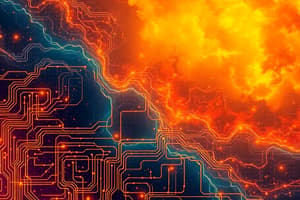Podcast
Questions and Answers
What does Ohm's Law state about current, voltage, and resistance?
What does Ohm's Law state about current, voltage, and resistance?
- Current is directly proportional to voltage and inversely proportional to resistance. (correct)
- Voltage is inversely proportional to resistance.
- Current is directly proportional to resistance.
- Current is inversely proportional to voltage.
In a series circuit, how is the total resistance calculated?
In a series circuit, how is the total resistance calculated?
- By adding the inverses of individual resistances.
- By dividing the sum of voltages by the current.
- By adding all individual resistances together. (correct)
- By multiplying all individual resistances.
What is the primary function of a capacitor in an electrical circuit?
What is the primary function of a capacitor in an electrical circuit?
- To allow current to flow in one direction.
- To reduce voltage.
- To store and release energy. (correct)
- To increase current flow.
Which of the following is true about alternating current (AC)?
Which of the following is true about alternating current (AC)?
What safety measure automatically shuts off electrical circuits in case of an overload?
What safety measure automatically shuts off electrical circuits in case of an overload?
Which formula correctly represents the calculation of electrical power?
Which formula correctly represents the calculation of electrical power?
What device is used to measure voltage, current, and resistance?
What device is used to measure voltage, current, and resistance?
What component allows current to flow in one direction only?
What component allows current to flow in one direction only?
Flashcards are hidden until you start studying
Study Notes
Basic Electrical Concepts
1. Electrical Fundamentals
- Voltage (V): The electrical potential difference between two points. Measured in volts (V).
- Current (I): The flow of electric charge through a conductor. Measured in amperes (A).
- Resistance (R): The opposition to the flow of current in a circuit. Measured in ohms (Ω).
2. Ohm's Law
- Formula: ( V = I \times R )
- Voltage = Current × Resistance
- States that the current flowing through a conductor between two points is directly proportional to the voltage across the two points and inversely proportional to the resistance.
3. Electrical Circuits
-
Series Circuit: Components connected end-to-end, so the same current flows through all components.
- Total Resistance: ( R_{total} = R_1 + R_2 + ... + R_n )
-
Parallel Circuit: Components connected across the same voltage source, allowing multiple paths for current.
- Total Resistance: ( \frac{1}{R_{total}} = \frac{1}{R_1} + \frac{1}{R_2} + ... + \frac{1}{R_n} )
4. Power in Electrical Circuits
- Power (P): The rate at which electrical energy is transferred or converted. Measured in watts (W).
- Formula: ( P = V \times I ) or ( P = I^2 \times R ) or ( P = \frac{V^2}{R} )
5. Electrical Components
- Resistors: Limit current flow and reduce voltage.
- Capacitors: Store and release energy, used for filtering and timing applications.
- Inductors: Store energy in a magnetic field when current passes through.
- Diodes: Allow current to flow in one direction only.
- Transistors: Act as switches or amplifiers for electrical signals.
6. AC vs. DC
- Alternating Current (AC): Current that reverses direction periodically. Commonly used in home power supply.
- Direct Current (DC): Current that flows in one direction only. Used in batteries and electronic devices.
7. Safety Measures
- Circuit Breakers: Automatically shut off electrical circuits to prevent overload.
- Fuses: Safety devices that melt and break the circuit when excessive current flows.
- Grounding: Provides a safe path for electricity in case of a fault.
8. Electrical Measurements
- Multimeter: A tool used to measure voltage, current, and resistance.
- Clamp Meter: Measures current by clamping around a conductor without direct contact.
9. Electrical Symbols
- Know basic circuit symbols for components like resistors, capacitors, batteries, and switches for circuit diagrams.
Summary
Understanding these basic electrical concepts is crucial for working with circuits and electronic devices. Familiarity with Ohm's Law, circuit types, and components is essential for effective application in electrical engineering and related fields.
Basic Electrical Concepts
Electrical Fundamentals
- Voltage (V): Electrical potential difference, measured in volts (V).
- Current (I): Flow of electric charge, measured in amperes (A).
- Resistance (R): Opposition to current flow in a circuit, measured in ohms (Ω).
Ohm's Law
- Formula: ( V = I \times R ) indicates voltage is the product of current and resistance.
- Establishes the relationship that current is directly proportional to voltage and inversely proportional to resistance.
Electrical Circuits
-
Series Circuit: Components connected in a single path, ensuring the same current flows through all.
-
Total Resistance in Series: Sum of all individual resistances ( R_{total} = R_1 + R_2 +...+ R_n ).
-
Parallel Circuit: Components connected across the same voltage source, allowing multiple current paths.
-
Total Resistance in Parallel: Reciprocal sum of individual resistances ( \frac{1}{R_{total}} = \frac{1}{R_1} + \frac{1}{R_2} +...+ \frac{1}{R_n} ).
Power in Electrical Circuits
- Power (P): Rate of electrical energy transfer, measured in watts (W).
- Power Formula: Can be calculated as ( P = V \times I ), ( P = I^2 \times R ), or ( P = \frac{V^2}{R} ).
Electrical Components
- Resistors: Control current flow and reduce voltage.
- Capacitors: Store and release energy, utilized in filtering and timing applications.
- Inductors: Store energy in a magnetic field when current flows through.
- Diodes: Ensure current flows in one direction only.
- Transistors: Serve as switches or amplifiers for electrical signals.
AC vs. DC
- Alternating Current (AC): Reverses direction periodically, commonly used for home power supply.
- Direct Current (DC): Flows in one direction, primarily used in batteries and electronic devices.
Safety Measures
- Circuit Breakers: Automatically disconnect circuits to prevent overload conditions.
- Fuses: Melt to disconnect a circuit when excessive current is detected.
- Grounding: Creates a safe pathway for electricity in fault scenarios.
Electrical Measurements
- Multimeter: Instrument used for measuring voltage, current, and resistance.
- Clamp Meter: Measures current without needing to make direct contact, clamping around the conductor.
Electrical Symbols
- Familiarity with circuit symbols for components like resistors, capacitors, batteries, and switches is essential for understanding circuit diagrams.
Summary
Understanding these electrical concepts is vital for effective application in electrical engineering and related fields. Knowledge of Ohm's Law, circuit types, and components greatly aids in working with circuits and electronic devices.
Studying That Suits You
Use AI to generate personalized quizzes and flashcards to suit your learning preferences.




